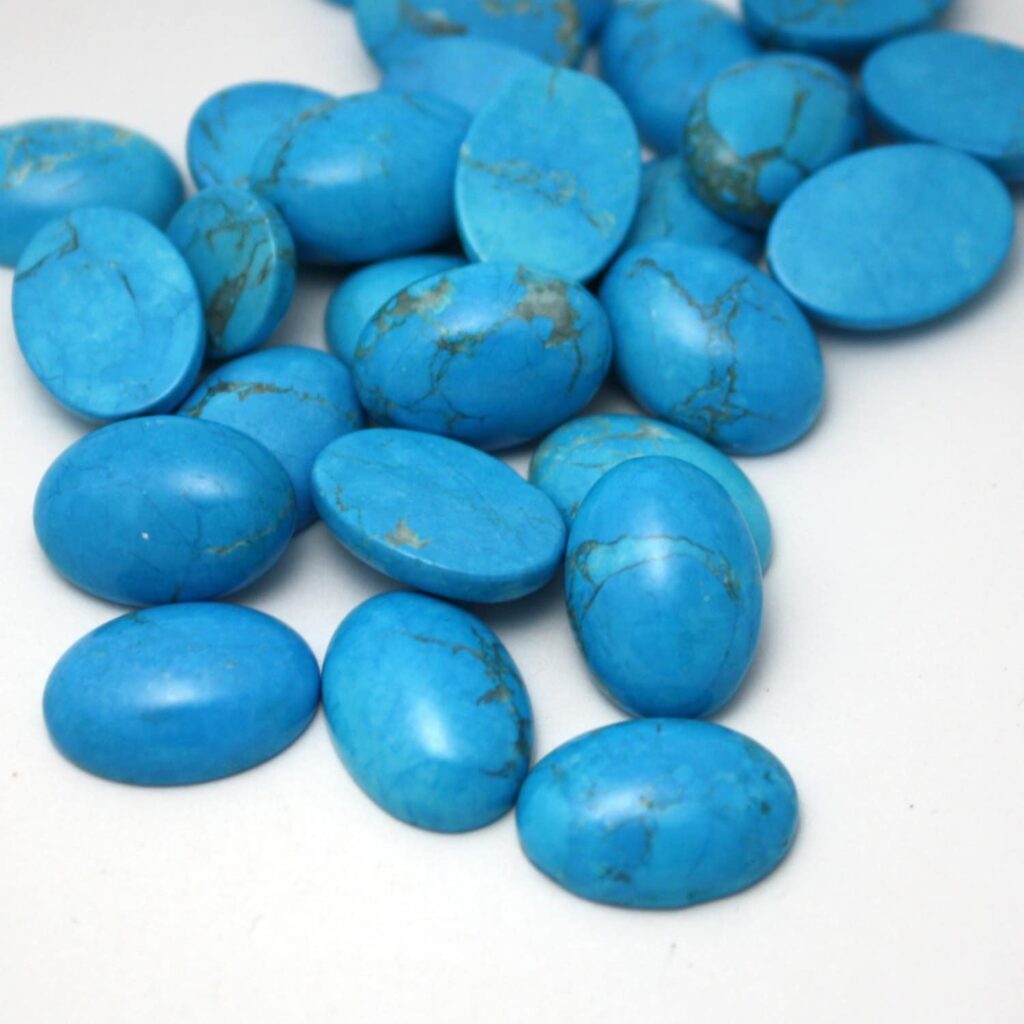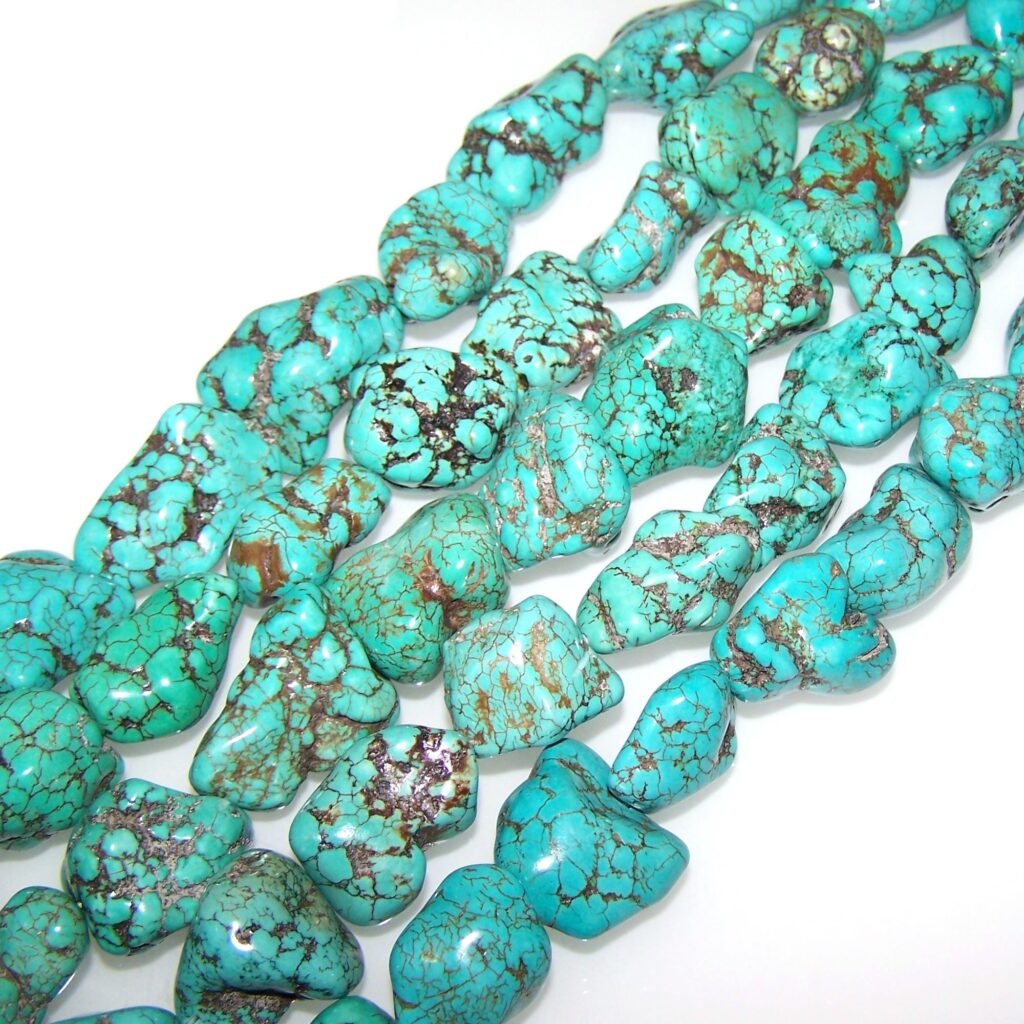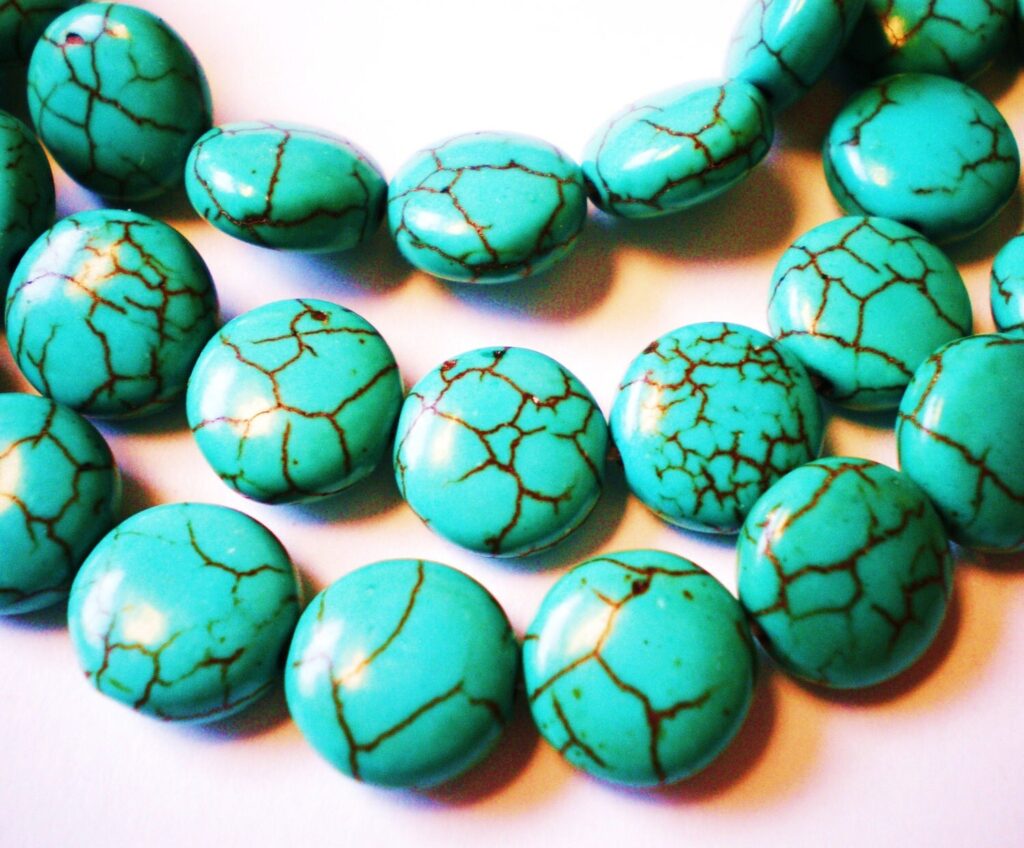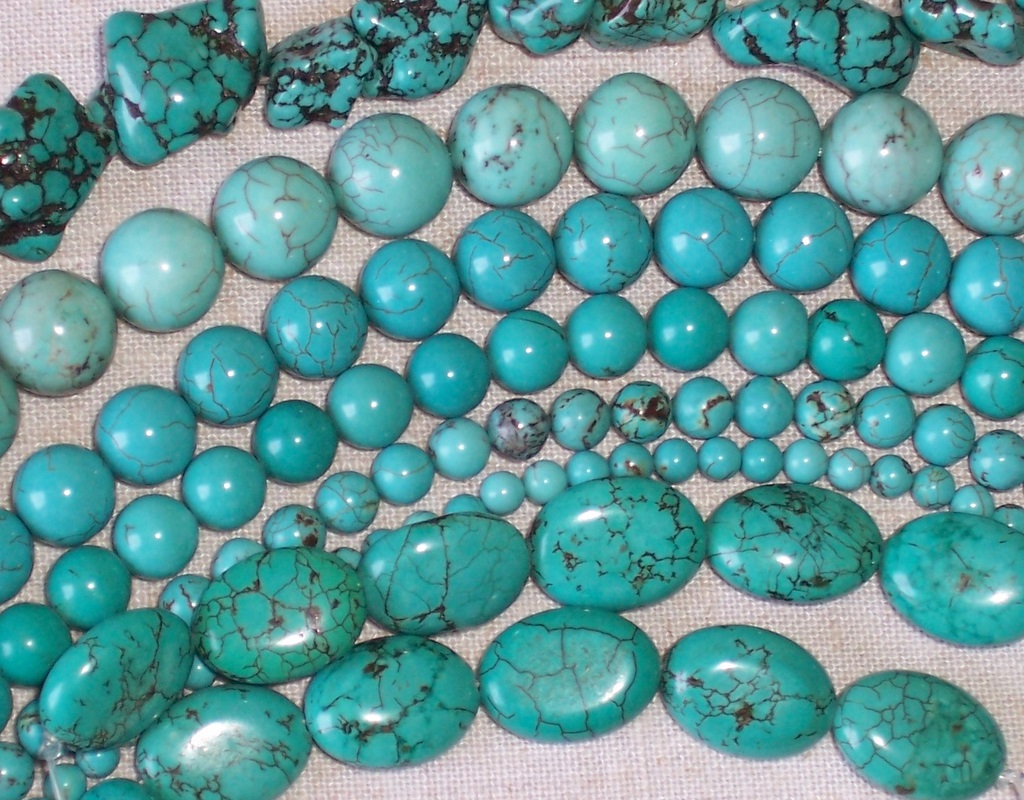Turquoise Howlite is a captivating gemstone renowned for its striking resemblance to natural turquoise. However, it’s important to note that Turquoise Howlite is not a genuine turquoise stone; instead, it is a white or light gray mineral known as howlite that has been dyed to mimic the appearance of turquoise.

Definition and Composition: Howlite is a borate mineral that belongs to the same family as other borate minerals like borax and ulexite. Its chemical composition is calcium borosilicate hydroxide (Ca2B5SiO9(OH)5). Howlite is naturally white or gray with veins or patches of black matrix, which gives it a distinctive appearance. To create Turquoise Howlite, the naturally occurring howlite is often dyed to replicate the vibrant blue-green hues of turquoise. This process allows for the creation of affordable jewelry and decorative items with a turquoise-like appearance.
Origin and History: Howlite was first discovered in Nova Scotia, Canada, in the mid-19th century by geologist Henry How. It was named after him in recognition of his contributions to the field of mineralogy. While howlite itself has been known since the 19th century, the practice of dyeing it to resemble turquoise became popular later on.
The exact origins of Turquoise Howlite as a gemstone are a bit more ambiguous due to its manufactured nature. However, its popularity surged in the mid to late 20th century as an affordable alternative to genuine turquoise. Jewelers and artisans appreciated its similarity to turquoise while being more economical and readily available.
In contemporary times, Turquoise Howlite continues to be prized for its striking appearance and versatility in jewelry making. It is often used in beaded necklaces, bracelets, earrings, and other accessories. Additionally, it finds its place in ornamental carvings and sculptures due to its ease of shaping and dyeing. Despite not being a natural gemstone, Turquoise Howlite has carved out its niche in the world of fashion and decorative arts, offering an accessible option for those who admire the beauty of turquoise but seek a more budget-friendly alternative.
Significance in Jewelry Making and Ornamental Use

Turquoise Howlite holds significant appeal in jewelry making and ornamental use for several reasons:
- Affordability: One of the most notable aspects of Turquoise Howlite is its affordability compared to genuine turquoise. Howlite itself is relatively inexpensive, and the dyeing process further reduces the cost. This makes Turquoise Howlite a popular choice for individuals looking for turquoise-like jewelry without the price tag associated with genuine turquoise.
- Versatility: Turquoise Howlite is highly versatile in jewelry making due to its ease of shaping and manipulation. It can be carved into various shapes, sizes, and designs, making it suitable for a wide range of jewelry styles, from intricate beadwork to bold statement pieces.
- Color Consistency: Unlike natural turquoise, which can vary greatly in color and veining depending on its origin and quality, Turquoise Howlite offers consistency in color. This allows jewelry designers to create pieces with a uniform appearance, ensuring that each component complements the overall design.
- Durability: Howlite itself is a relatively durable mineral, making Turquoise Howlite jewelry resistant to scratches and chipping with proper care. While it may not possess the same hardness as genuine turquoise, it still offers sufficient durability for everyday wear.
- Availability: Turquoise Howlite is more readily available than natural turquoise, making it easier for jewelry makers to source consistent supplies. This accessibility ensures that designers can incorporate Turquoise Howlite into their creations without facing the supply constraints often associated with rare or high-demand gemstones.
- Aesthetic Appeal: Despite being a dyed mineral, Turquoise Howlite boasts a captivating appearance with its vibrant blue-green hues reminiscent of genuine turquoise. Its striking coloration and veining patterns make it an eye-catching choice for both casual and formal jewelry designs.
- Ornamental Use: In addition to jewelry making, Turquoise Howlite is also popular for ornamental use in sculptures, carvings, and decorative items. Its ease of carving and dyeing allows artisans to create intricate designs and embellishments, adding a touch of elegance to various home decor pieces.
Overall, Turquoise Howlite holds significant significance in jewelry making and ornamental use, offering an affordable yet visually appealing alternative to genuine turquoise. Its versatility, durability, and aesthetic appeal make it a favored choice among designers and artisans seeking to create beautiful and accessible pieces for their customers.
Physical Characteristics

The physical characteristics of Turquoise Howlite encompass its appearance, properties, and composition:
- Color: Turquoise Howlite typically exhibits a vibrant blue-green coloration that closely resembles natural turquoise. However, the color may vary slightly depending on the dyeing process and the quality of the howlite used. The hue can range from light turquoise to deeper shades of blue-green.
- Texture: Turquoise Howlite has a smooth and often polished texture, especially when used in jewelry making. However, in its natural form, howlite may have a slightly porous or granular texture.
- Veining: Similar to natural turquoise, Turquoise Howlite may feature veining or matrix patterns that mimic the appearance of genuine turquoise. These dark lines or patches contrast with the vibrant blue-green background, adding depth and character to the stone.
- Transparency: Turquoise Howlite is typically opaque, meaning that it does not allow light to pass through. This opacity contributes to its vivid color and enhances its resemblance to genuine turquoise.
- Hardness: Howlite has a Mohs hardness of around 3.5 to 6.5, making it relatively soft compared to other gemstones. While this hardness level provides sufficient durability for jewelry making and ornamental use, Turquoise Howlite may still be susceptible to scratching and chipping with excessive wear or rough handling.
- Luster: Turquoise Howlite exhibits a waxy to vitreous luster, depending on its surface finish and quality. When polished, it can display a glossy sheen that enhances its visual appeal.
- Density: The density of Turquoise Howlite varies depending on its composition and the presence of impurities. On average, it has a density ranging from 2.53 to 2.59 grams per cubic centimeter.
- Structure: Turquoise Howlite belongs to the monoclinic crystal system and typically forms in irregular masses or nodules. Its crystal structure is characterized by intersecting cleavage planes and a prismatic habit.
These physical characteristics collectively contribute to the unique appearance and allure of Turquoise Howlite, making it a popular choice for jewelry making, decorative arts, and ornamental use.
Geological Formation

Turquoise Howlite, like natural howlite, forms through a process known as hydrothermal alteration in boron-rich environments. Here’s a brief overview of the geological formation of howlite and subsequently Turquoise Howlite:
- Formation of Howlite: Howlite is a borate mineral that typically forms in boron-rich sedimentary deposits. These deposits are often associated with volcanic activity and hydrothermal alteration zones. During hydrothermal processes, hot water containing dissolved minerals percolates through the surrounding rocks, depositing minerals and altering existing minerals in the process.
- Boron-Rich Environments: Boron-rich environments, where howlite forms, are often found near volcanic regions or in sedimentary basins associated with volcanic activity. Boron is introduced into the environment through volcanic gases and hydrothermal fluids, where it reacts with other elements to form borate minerals like howlite.
- Precipitation and Crystallization: As the hydrothermal fluids cool and interact with the surrounding rock formations, conditions become favorable for the precipitation and crystallization of howlite. The specific mineral composition of the surrounding rocks, as well as factors such as temperature, pressure, and pH, influence the formation of howlite crystals.
- Dyeing Process (for Turquoise Howlite): After howlite is extracted from the earth, it undergoes a dyeing process to achieve the vibrant blue-green coloration characteristic of Turquoise Howlite. This process typically involves immersing the howlite in a solution containing dyes or pigments, which are absorbed into the porous structure of the mineral. The howlite is then heated to set the color, resulting in Turquoise Howlite.
It’s important to note that Turquoise Howlite is not a naturally occurring mineral; rather, it is a dyed form of howlite designed to mimic the appearance of turquoise. While the geological formation of howlite follows the processes outlined above, the dyeing of howlite to create Turquoise Howlite is a human-made process aimed at enhancing its aesthetic appeal for use in jewelry making and decorative arts.
Uses and Applications

Turquoise Howlite finds a variety of uses and applications in jewelry making, decorative arts, and other industries:
- Jewelry Making: Turquoise Howlite is extensively used in jewelry making due to its vibrant blue-green color and resemblance to natural turquoise. It is shaped into beads, cabochons, and other forms to create earrings, necklaces, bracelets, rings, and pendants. Jewelry designers appreciate its affordability, versatility, and availability, allowing them to create a wide range of designs to suit different tastes and preferences.
- Ornamental Use: Turquoise Howlite is also popular for ornamental use in decorative arts and crafts. It can be carved, sculpted, and polished to create ornate figurines, carvings, and decorative objects. Its striking color and resemblance to turquoise make it a favored choice for adding a touch of elegance to home decor, such as vases, bowls, and statues.
- Beadwork and Accessories: In addition to traditional jewelry making, Turquoise Howlite beads are widely used in beadwork and accessories. They are incorporated into bead strings, bracelets, and earrings, as well as used as embellishments for clothing, handbags, and footwear. The versatility of Turquoise Howlite beads allows for endless creative possibilities in fashion and accessory design.
- Metaphysical and Spiritual Practices: Turquoise Howlite is sometimes associated with metaphysical properties and spiritual practices. It is believed to possess calming and soothing energies, making it popular for use in meditation practices, crystal healing, and alternative therapies. Some people use Turquoise Howlite as a symbol of tranquility, wisdom, and spiritual growth.
- Educational and Geological Studies: Howlite, including its dyed form as Turquoise Howlite, is studied by geologists and mineral enthusiasts for its geological significance. Its formation processes, chemical composition, and crystal structure provide valuable insights into geological processes and mineralogy. Additionally, Turquoise Howlite specimens are often used for educational purposes in schools, museums, and geological exhibits.
- Crafts and DIY Projects: Turquoise Howlite beads, cabochons, and chips are popular choices for crafters and DIY enthusiasts. They can be incorporated into various projects such as wire wrapping, macramé, resin art, and home decor crafts. Turquoise Howlite provides an affordable and visually appealing option for adding color and texture to handmade creations.
Overall, Turquoise Howlite’s versatility, affordability, and aesthetic appeal make it a valuable resource in numerous industries and creative endeavors, ranging from jewelry making to decorative arts and beyond.
Occurrence and Distribution

Howlite, the mineral from which Turquoise Howlite is derived, is found in various locations around the world, often in association with boron-rich environments and volcanic activity. Some of the notable occurrences and distributions of howlite include:
- Canada: Howlite was first discovered in Nova Scotia, Canada, in the mid-19th century by geologist Henry How, after whom the mineral is named. The discovery site near Windsor, Nova Scotia, remains one of the most significant sources of natural howlite.
- United States: Howlite is also found in several locations throughout the United States, including California, Oregon, and Nevada. In California, significant deposits have been identified in the Mojave Desert and the San Bernardino County.
- Mexico: Mexico is another notable producer of howlite, particularly in the state of Chihuahua. Howlite deposits in Mexico often occur in association with other borate minerals and are mined for both industrial and ornamental purposes.
- South Africa: Howlite deposits have been reported in South Africa, particularly in the Northern Cape Province. These deposits are often associated with boron-rich sedimentary rocks and volcanic formations.
- Germany: Howlite occurrences have been documented in Germany, primarily in the regions of Saxony and Bavaria. These deposits are typically associated with sedimentary rocks and hydrothermal alteration zones.
- Other Countries: Howlite has also been found in smaller quantities in other countries, including Turkey, Russia, Brazil, and Pakistan. These occurrences are often localized and may not be as extensively mined as those in the aforementioned regions.
While howlite is found in various locations worldwide, the availability and distribution of Turquoise Howlite, the dyed form of howlite, are influenced by factors such as market demand, accessibility, and manufacturing processes. Turquoise Howlite may be produced from natural howlite obtained from any of these global sources and is then processed and dyed to achieve its distinctive blue-green coloration. As a result, Turquoise Howlite jewelry and decorative items are distributed globally through jewelry retailers, wholesalers, and online marketplaces.




































